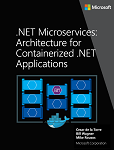Apply CQRS and CQS approaches in a DDD microservice in eShopOnContainers
Tip
This content is an excerpt from the eBook, .NET Microservices Architecture for Containerized .NET Applications, available on .NET Docs or as a free downloadable PDF that can be read offline.

The design of the ordering microservice at the eShopOnContainers reference application is based on CQRS principles. However, it uses the simplest approach, which is just separating the queries from the commands and using the same database for both actions.
The essence of those patterns, and the important point here, is that queries are idempotent: no matter how many times you query a system, the state of that system won't change. In other words, queries are side-effect free.
Therefore, you could use a different "reads" data model than the transactional logic "writes" domain model, even though the ordering microservices are using the same database. Hence, this is a simplified CQRS approach.
On the other hand, commands, which trigger transactions and data updates, change state in the system. With commands, you need to be careful when dealing with complexity and ever-changing business rules. This is where you want to apply DDD techniques to have a better modeled system.
The DDD patterns presented in this guide should not be applied universally. They introduce constraints on your design. Those constraints provide benefits such as higher quality over time, especially in commands and other code that modifies system state. However, those constraints add complexity with fewer benefits for reading and querying data.
One such pattern is the Aggregate pattern, which we examine more in later sections. Briefly, in the Aggregate pattern, you treat many domain objects as a single unit as a result of their relationship in the domain. You might not always gain advantages from this pattern in queries; it can increase the complexity of query logic. For read-only queries, you do not get the advantages of treating multiple objects as a single Aggregate. You only get the complexity.
As shown in Figure 7-2 in the previous section, this guide suggests using DDD patterns only in the transactional/updates area of your microservice (that is, as triggered by commands). Queries can follow a simpler approach and should be separated from commands, following a CQRS approach.
For implementing the "queries side", you can choose between many approaches, from your full-blown ORM like EF Core, AutoMapper projections, stored procedures, views, materialized views or a micro ORM.
In this guide and in eShopOnContainers (specifically the ordering microservice) we chose to implement straight queries using a micro ORM like Dapper. This guide lets you implement any query based on SQL statements to get the best performance, thanks to a light framework with little overhead.
When you use this approach, any updates to your model that impact how entities are persisted to a SQL database also need separate updates to SQL queries used by Dapper or any other separate (non-EF) approaches to querying.
CQRS and DDD patterns are not top-level architectures
It's important to understand that CQRS and most DDD patterns (like DDD layers or a domain model with aggregates) are not architectural styles, but only architecture patterns. Microservices, SOA, and event-driven architecture (EDA) are examples of architectural styles. They describe a system of many components, such as many microservices. CQRS and DDD patterns describe something inside a single system or component; in this case, something inside a microservice.
Different Bounded Contexts (BCs) will employ different patterns. They have different responsibilities, and that leads to different solutions. It is worth emphasizing that forcing the same pattern everywhere leads to failure. Do not use CQRS and DDD patterns everywhere. Many subsystems, BCs, or microservices are simpler and can be implemented more easily using simple CRUD services or using another approach.
There is only one application architecture: the architecture of the system or end-to-end application you are designing (for example, the microservices architecture). However, the design of each Bounded Context or microservice within that application reflects its own tradeoffs and internal design decisions at an architecture patterns level. Do not try to apply the same architectural patterns as CQRS or DDD everywhere.
Additional resources
Martin Fowler. CQRS
https://martinfowler.com/bliki/CQRS.htmlGreg Young. CQRS Documents
https://cqrs.files.wordpress.com/2010/11/cqrs_documents.pdfUdi Dahan. Clarified CQRS
https://udidahan.com/2009/12/09/clarified-cqrs/
